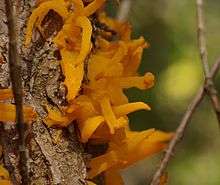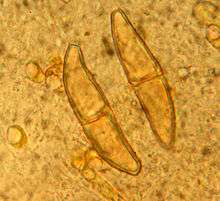Telium
Telium, plural telia, are structures produced by rust fungi as part of the reproductive cycle.[1] They are typically yellow or orange drying to brown or black and are exclusively a mechanism for the release of teliospores which are released by wind or water to infect the alternate host in the rust life-cycle. The telial stage is one of the stages in the life cycle of a parasitic heteroecious fungus; it is spent on the secondary host plant. A primary aecial stage is spent parasitizing a separate host plant which is a precursor in the life cycle of heteroecious fungi. Spores are released from the telia in the spring. The spores can spread many kilometers through the air, however most are spread near the host plant.[2]


Host plants
There are a number of plants that can be infected by the telial stage. Therefore, the telial stage is considered a pathogen to those plants. A few specific plant pathogenic species are listed here with their hosts.
- Puccinia graminis or known commonly as black stem rust. It infects many different cereal crops.
- Gymnosporangium juniperi-virginianae. It infects the eastern red cedar.[3] This is shown to the right.
- Gymnosporangium sabinae. It infects pear trees.
 Puccinia graminis on wheat.
Puccinia graminis on wheat.- Gymnosporangium sabinae on a pear tree leaf.
Spore stages
The life cycle of rust fungi can have up to five different spore stages and can get quite complex.[4] These stages are:
- Stage 0: Pycniospores
- Stage I: Aeciospores
- Stage II: Urediniospores
- Stage III: Teliospores
- Stage IV: Basidiospores
 Life Cycle of Puccina graminis
Life Cycle of Puccina graminis
References
- Brand g, Brand R & Shattock R,.Sorting out Gymnosporangium species - the aecial stage, October 2006, Field Mycology Volume 7(4)
- Brand, A.W. et al. 2004. The Other Half: The telial stage of the rust fungus Gymnosporangium confusum. Field Mycology. Vol 5:14-16
- Volk, T.J. Tom Volk's Fungus of the Month for May 1999. University of Wisconsin La Crosse. http://botit.botany.wisc.edu/toms_fungi/may99.html, December 5, 2010
- Schumann, G.L. et al. 2010. Essential Plant Pathology. American Phytopathological Society. Second Edition. St. Paul. pp. 43–44